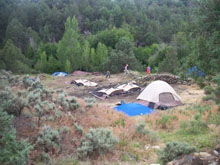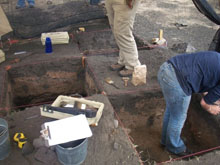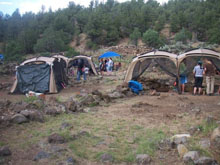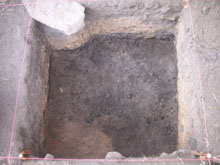 A Southern Methodist University terrestrial excavation site
of a whiskey distillery and mill. Click on each image for larger view.
A Southern Methodist University terrestrial excavation site
of a whiskey distillery and mill. Click on each image for larger view. A Southern Methodist University terrestrial excavation site of a whiskey distillery and mill. Click on each image for larger view.
A Southern Methodist University terrestrial excavation site of a whiskey distillery and mill. Click on each image for larger view.

The Southern Methodist University terrestrial excavation site
of a whiskey distillery and mill. Click on each image for larger view.
The Southern Methodist University terrestrial excavation site of a whiskey distillery and mill. Click on each image for larger view.
Field Techniques and Operations:
Terrestrial vs Maritime
July 27, 2009
Ben Wells
Mercyhurst College
![]() Watch deployment of the Zodiac inflatable boat.
Watch deployment of the Zodiac inflatable boat.
After spending about seven weeks in Taos, New Mexico, excavating at Cantonment Burgwin, I found myself involved in an underwater project in the Gulf of Mexico. It was quite a change to go from terrestrial work to that of underwater in such a short time (one week). It became apparent that the work I was involved in now consisted of entirely different practices, methods, and scope.
As the case was at Cantonment Burgwin, we knew exactly what type of structure we were dealing with — a laundress quarters; and, thus, we could form multiple research questions based around this idea. Because we had maps of the cantonment, we knew exactly where to excavate in order to expose the various aspects we wanted to uncover. Additionally, our method was one that has been tried and tested in a large suite of sites and is known to be extremely precise.
In sharp contrast, the work in the Gulf was quite different. First of all, no one had mapped out the areas we were interested in, nor were they any clear definitions of general locales to begin the search. Of course, we had numerous research questions, but these were all limited by our understanding of the clime in which we were now functioning . . . a clime which — until this project — has been mainly left alone. Excavations varied from location to location, consisting of coring, hand-clearing sandy areas, and utilizing geologic hammers to break away heavy overgrowth. Time was limited to how long divers could stay underwater, whereas at a terrestrial site workers can work at least 10 hours per day.
Though the crossover was quite different, the overarching goal was still the same: to acquire accurate data concerning a particular point in the general history of time.
Sign up for the Ocean Explorer E-mail Update List.















